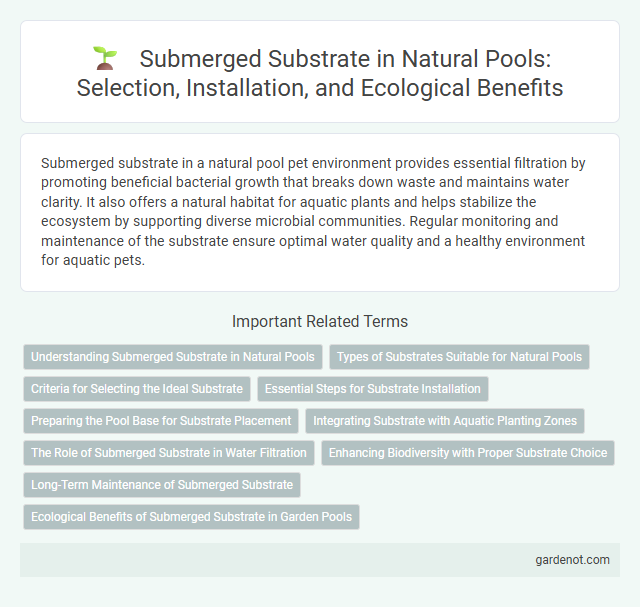Submerged substrate in a natural pool pet environment provides essential filtration by promoting beneficial bacterial growth that breaks down waste and maintains water clarity. It also offers a natural habitat for aquatic plants and helps stabilize the ecosystem by supporting diverse microbial communities. Regular monitoring and maintenance of the substrate ensure optimal water quality and a healthy environment for aquatic pets.
Understanding Submerged Substrate in Natural Pools
Submerged substrate in natural pools consists of various materials like gravel, sand, and aquatic plants that provide essential filtration and habitat functions. These substrates support beneficial microbial communities that break down organic matter, maintaining water clarity and ecological balance. Understanding the composition and role of submerged substrate is crucial for designing effective natural pool ecosystems that promote sustainable water quality.
Types of Substrates Suitable for Natural Pools
Natural pools thrive on various submerged substrates such as gravel, sand, and coarse stone, which provide essential support for aquatic plants and beneficial microorganisms. Gravel substrates with particle sizes ranging from 2 to 10 millimeters promote effective biological filtration and water clarity by facilitating nutrient absorption. Coarse stones create habitats for microfauna, enhancing biodiversity and maintaining the ecological balance within the natural pool system.
Criteria for Selecting the Ideal Substrate
The ideal submerged substrate for a natural pool must exhibit high porosity to support beneficial microbial colonies that enhance water filtration. It should be chemically inert to prevent altering the pool's pH balance and maintain ecological stability. Grain size is crucial, with a preference for medium to coarse particles to facilitate water flow and prevent clogging, ensuring sustained nutrient cycling within the aquatic ecosystem.
Essential Steps for Substrate Installation
Installing a submerged substrate in a natural pool requires selecting inert materials such as gravel, sand, or quartz that promote beneficial microbial activity and water filtration. The substrate must be laid evenly on a stable base to prevent compaction and ensure proper water circulation. Proper depth, typically between 4 to 8 inches, is crucial to support aquatic plants and maintain optimal water quality.
Preparing the Pool Base for Substrate Placement
Preparing the pool base for substrate placement involves thorough cleaning and leveling to ensure optimal drainage and stability. A waterproof liner or layer is often installed to prevent water seepage and protect the substrate from erosion. Proper base preparation supports the natural pool's ecological balance and enhances the longevity of submerged substrates such as gravel, sand, or clay.
Integrating Substrate with Aquatic Planting Zones
Submerged substrate plays a crucial role in the stability and health of aquatic planting zones within natural pools by providing essential nutrients and anchorage for plant roots. Utilizing a layered substrate system composed of gravel, sand, and organic soil enhances water filtration and supports diverse aquatic vegetation. Proper integration of substrate materials ensures optimal growth conditions for submerged plants, contributing to improved water clarity and ecosystem balance.
The Role of Submerged Substrate in Water Filtration
Submerged substrate plays a critical role in natural pool water filtration by providing a habitat for beneficial microorganisms that break down organic matter and pollutants. The porous surface of submerged materials, such as gravel or sand, increases the surface area for biofilm development, enhancing the natural purification process. This biological filtration helps maintain water clarity and balances nutrient levels, reducing the need for chemical treatments.
Enhancing Biodiversity with Proper Substrate Choice
Choosing the right submerged substrate in a natural pool significantly enhances biodiversity by providing essential habitats for aquatic plants, invertebrates, and microorganisms. Materials such as gravel, sand, and clay offer varied pore sizes that support root development and microbial colonization, promoting a balanced ecosystem. Proper substrate selection also improves water filtration and nutrient cycling, fostering a thriving, self-sustaining aquatic environment.
Long-Term Maintenance of Submerged Substrate
The long-term maintenance of a submerged substrate in a natural pool involves regular monitoring to prevent sediment buildup and ensure optimal water flow. Utilizing biofilters and aquatic plants can enhance substrate stability by promoting beneficial microbial activity and natural nutrient cycling. Consistent removal of organic debris and periodic substrate agitation helps maintain ecological balance and prolongs the substrate's effectiveness in water purification.
Ecological Benefits of Submerged Substrate in Garden Pools
Submerged substrate in garden pools serves as a vital habitat for aquatic microorganisms, promoting biodiversity and natural filtration processes that improve water quality. These substrates support beneficial bacteria that break down organic matter and reduce harmful nutrients, preventing algae overgrowth. Incorporating natural materials like gravel or sand enhances ecosystem stability while fostering a balanced aquatic environment.
Submerged substrate Infographic

 gardenot.com
gardenot.com